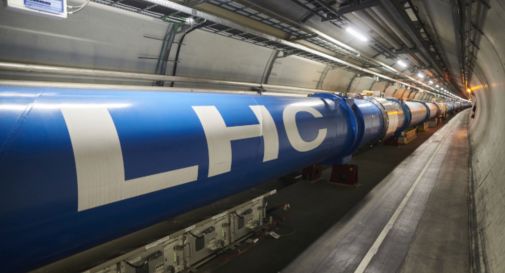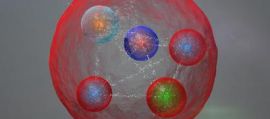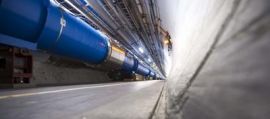Il Large Hadron Collider riparte alla ricerca della misteriosa materia oscura, della nuova fisica e di una quinta forza della natura
Dopo una pausa di tre anni, si prevede che un LHC aggiornato farà scoperte sia in cosmologia che in fisica delle particelle che potrebbero dare inizio alla più grande rivoluzione degli ultimi cento anni.
| Richard Brewer |

credito immagine CERN
GINEVRA - Alle 12:16 CEST del 22 aprile 2022, il laboratorio del CERN Large Hadron Collider (LHC) è stato riavviato dopo essere stato chiuso per lavori di manutenzione e importanti aggiornamenti dal 2018. Nelle profondità delle Alpi, i fisici hanno inviato due raggi di protoni in direzioni opposte intorno al tunnel circolare di 27 chilometri (17 miglia) dell'acceleratore di particelle più grande e potente del mondo. L'LHC fa parte dell'Organizzazione europea per la ricerca nucleare al confine franco-svizzero, appena fuori Ginevra. Questo segna l'inizio della 3a serie di prove che, con gli strumenti aggiornati e una potenza del raggio più densa, fornirà la migliore possibilità che LHC trovi ancora particelle subatomiche che sono completamente nuove per la scienza. La speranza è che farà scoperte che scateneranno la più grande rivoluzione della fisica degli ultimi cento anni.
Durante questa nuova serie di ricerche scientifiche, potrebbero finalmente risolvere un'anomalia che indicava la potenziale esistenza di una quinta forza fondamentale della natura che era rimasta inspiegabile tre anni fa quando LHC è stato spento. Inoltre, i ricercatori sperano di trovare prove della sostanza invisibile chiamata Materia Oscura che costituisce la maggior parte dell'Universo ma deve ancora essere rilevata direttamente ed è stata dedotta solo dai suoi effetti gravitazionali sul cosmo.
Negli anni '80 gli astronomi conclusero che la maggior parte della massa nell'universo era costituita da materia oscura, una forma invisibile di massa non luminosa che tiene insieme le galassie con la sua attrazione gravitazionale e le collega tutte in una vasta rete cosmica. Da allora gli sperimentatori di tutto il mondo hanno dato la caccia alle misteriose particelle invisibili. Le collisioni di protoni ad alta energia all'interno dell'LHC ricreeranno momentaneamente alcune delle condizioni che esistevano all'inizio dell'universo e la speranza è che, se l'Universo ha creato la materia oscura ~ 14 miliardi di anni fa, forse LHC può fare lo stesso.
Il Modello Standard della fisica delle particelle è una delle strutture teoriche più testate e completamente confermate della storia, ma non può spiegare come opera la gravità né come si comportano la Materia Oscura e l'Energia Oscura. Il nostro universo è fatto di oscurità e ora sappiamo che lo spazio vuoto non è solo un vuoto senza caratteristiche: qualcos'altro è là fuori. Gli scienziati sanno che queste particelle e forze invisibili esistono dalle osservazioni del movimento delle galassie nello spazio e che insieme rappresentano il 95% dell'Universo, ma nessuno è ancora stato in grado di provare la loro esistenza e determinare cosa siano. L'LHC è stato costruito per creare e rilevare queste particelle esotiche che potrebbero spiegare come funziona la grande massa del cosmo.
Quest'estate LHC si unirà al telescopio spaziale James Webb e ad altri esperimenti sulla materia oscura nell'esplorazione di questo materiale oscuro invisibile. Webb ha recentemente terminato le sue fasi di raffreddamento e calibrazione e sarà pronto ad esplorare il ruolo della materia oscura nella formazione di galassie e stelle nell'universo primordiale mentre LHC cercherà di ricreare le energie che producono la materia oscura. Insieme ci sarà molto da imparare sulla natura dei costituenti fondamentali dell'universo e vi aspettano spettacolari scoperte.
.............IN ENGLISH ............
The Large Hadron Collider Restarts in search of mysterious dark matter, new physics and a fifth force of nature. After a three year break an upgraded LHC is expected to make discoveries in both cosmology and particle physics that could initiate the biggest revolution in a hundred years.
GENEVA— At 12:16 CEST (11:16 BST) on 22 April 2022, the CERN laboratory Large Hadron Collider (LHC) was restarted after being shutdown for maintenance and major upgrade work since 2018. Deep under the Alps, Physicists sent two beams of protons in opposite directions around the 27 kilometer (17 mile) circular tunnel of the world’s biggest and most powerful particle accelerator. The LHC is part of the European Organization for Nuclear Research on the Swiss-French border, just outside Geneva. This marks the beginning of the 3rd series of runs that, with the upgraded instruments and denser beam power, will provide the best chance yet of the LHC finding subatomic particles that are completely new to science. The hope is that it will make discoveries that will spark the biggest revolution in physics in a hundred years.
During this new series of science runs they may finally resolve an anomaly that pointed to the potential existence of a fifth fundamental force of nature that was left unexplained three years ago when LHC was switched off. In addition, researchers hope to find evidence of the invisible substance called Dark Matter that makes up most of the Universe but has yet to be detected directly and has only been inferred by its gravitational effects on the cosmos.
In the 1980s astronomers concluded that most of the mass in the universe consisted of dark matter, a non luminous invisible form of mass that holds galaxies together with its gravitational attraction and links them all into a vast cosmic web. Since then experimentalists around the world have hunted for the mysterious invisible particles. The high energy proton collisions inside the LHC will momentarily recreate some of the conditions that existed at the beginning of the universe and the hope is, if the Universe created dark matter ~ 14 billion years ago, maybe LHC can do the same.
The Standard Model of particle physics is one of the most tested and thoroughly confirmed theoretical frameworks in history but it can't explain how gravity operates nor can it explain how Dark Matter and Dark Energy behave. Our universe is made of darkness and we now know that empty space is not just a featureless void — something else is out there. Scientists know these invisible particles and forces exist from observations of the movement of galaxies in space and that together they account for 95 per cent of the Universe but no one has yet been able to prove their existence and determine what they are. The LHC was built to create and detect these exotic particles that might explain how the vast bulk of the cosmos works.
This summer LHC will join the James Webb Space telescope and other dark matter experiments in exploring this unseen dark material. Webb has recently finished its cooling and calibration steps and will be ready to explore the role of dark matter in the formation of galaxies and stars in the very early universe while LHC will try to recreate energies that produce the dark matter. Together there will be much to learn about the nature of the fundamental constituents of the universe and spectacular discoveries await.




